Curtin Hospital Nursing Care Plan: Heather Cook's Case Study, Ward 9A
VerifiedAdded on 2023/06/03
|8
|2600
|469
Practical Assignment
AI Summary
This assignment presents a comprehensive nursing care plan for a 48-year-old female patient, Heather Cook, admitted to Curtin Hospital's ward 9A. The plan addresses multiple nursing diagnoses including acute pain related to a stage one pressure injury, risk of infection related to an indwelling catheter, bowel incontinence related to multiple sclerosis, and impaired physical immobility. Each diagnosis includes expected outcomes and detailed nursing interventions with rationales. The plan incorporates the iSoBAR format for handover, providing a clear situation, background, assessment, recommendation, and agreed plan. The discharge plan offers guidance on medication management, home environment, hygiene, diet, and follow-up care. The plan emphasizes patient education and family support to ensure continuity of care and improved patient outcomes. References are included to support the evidence-based practice described in the care plan.
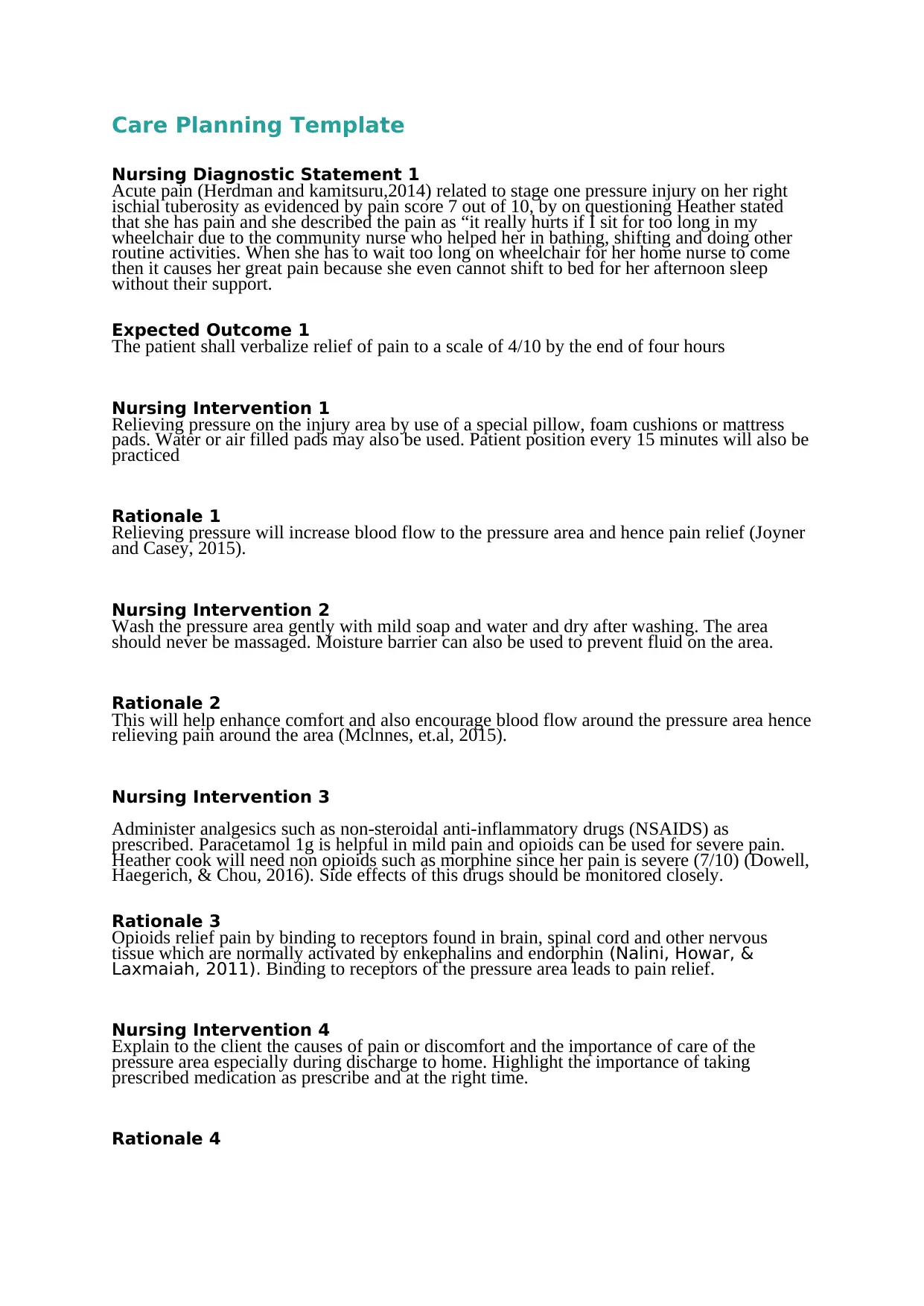
Care Planning Template
Nursing Diagnostic Statement 1
Acute pain (Herdman and kamitsuru,2014) related to stage one pressure injury on her right
ischial tuberosity as evidenced by pain score 7 out of 10, by on questioning Heather stated
that she has pain and she described the pain as “it really hurts if I sit for too long in my
wheelchair due to the community nurse who helped her in bathing, shifting and doing other
routine activities. When she has to wait too long on wheelchair for her home nurse to come
then it causes her great pain because she even cannot shift to bed for her afternoon sleep
without their support.
Expected Outcome 1
The patient shall verbalize relief of pain to a scale of 4/10 by the end of four hours
Nursing Intervention 1
Relieving pressure on the injury area by use of a special pillow, foam cushions or mattress
pads. Water or air filled pads may also be used. Patient position every 15 minutes will also be
practiced
Rationale 1
Relieving pressure will increase blood flow to the pressure area and hence pain relief (Joyner
and Casey, 2015).
Nursing Intervention 2
Wash the pressure area gently with mild soap and water and dry after washing. The area
should never be massaged. Moisture barrier can also be used to prevent fluid on the area.
Rationale 2
This will help enhance comfort and also encourage blood flow around the pressure area hence
relieving pain around the area (Mclnnes, et.al, 2015).
Nursing Intervention 3
Administer analgesics such as non-steroidal anti-inflammatory drugs (NSAIDS) as
prescribed. Paracetamol 1g is helpful in mild pain and opioids can be used for severe pain.
Heather cook will need non opioids such as morphine since her pain is severe (7/10) (Dowell,
Haegerich, & Chou, 2016). Side effects of this drugs should be monitored closely.
Rationale 3
Opioids relief pain by binding to receptors found in brain, spinal cord and other nervous
tissue which are normally activated by enkephalins and endorphin (Nalini, Howar, &
Laxmaiah, 2011). Binding to receptors of the pressure area leads to pain relief.
Nursing Intervention 4
Explain to the client the causes of pain or discomfort and the importance of care of the
pressure area especially during discharge to home. Highlight the importance of taking
prescribed medication as prescribe and at the right time.
Rationale 4
Nursing Diagnostic Statement 1
Acute pain (Herdman and kamitsuru,2014) related to stage one pressure injury on her right
ischial tuberosity as evidenced by pain score 7 out of 10, by on questioning Heather stated
that she has pain and she described the pain as “it really hurts if I sit for too long in my
wheelchair due to the community nurse who helped her in bathing, shifting and doing other
routine activities. When she has to wait too long on wheelchair for her home nurse to come
then it causes her great pain because she even cannot shift to bed for her afternoon sleep
without their support.
Expected Outcome 1
The patient shall verbalize relief of pain to a scale of 4/10 by the end of four hours
Nursing Intervention 1
Relieving pressure on the injury area by use of a special pillow, foam cushions or mattress
pads. Water or air filled pads may also be used. Patient position every 15 minutes will also be
practiced
Rationale 1
Relieving pressure will increase blood flow to the pressure area and hence pain relief (Joyner
and Casey, 2015).
Nursing Intervention 2
Wash the pressure area gently with mild soap and water and dry after washing. The area
should never be massaged. Moisture barrier can also be used to prevent fluid on the area.
Rationale 2
This will help enhance comfort and also encourage blood flow around the pressure area hence
relieving pain around the area (Mclnnes, et.al, 2015).
Nursing Intervention 3
Administer analgesics such as non-steroidal anti-inflammatory drugs (NSAIDS) as
prescribed. Paracetamol 1g is helpful in mild pain and opioids can be used for severe pain.
Heather cook will need non opioids such as morphine since her pain is severe (7/10) (Dowell,
Haegerich, & Chou, 2016). Side effects of this drugs should be monitored closely.
Rationale 3
Opioids relief pain by binding to receptors found in brain, spinal cord and other nervous
tissue which are normally activated by enkephalins and endorphin (Nalini, Howar, &
Laxmaiah, 2011). Binding to receptors of the pressure area leads to pain relief.
Nursing Intervention 4
Explain to the client the causes of pain or discomfort and the importance of care of the
pressure area especially during discharge to home. Highlight the importance of taking
prescribed medication as prescribe and at the right time.
Rationale 4
Paraphrase This Document
Need a fresh take? Get an instant paraphrase of this document with our AI Paraphraser
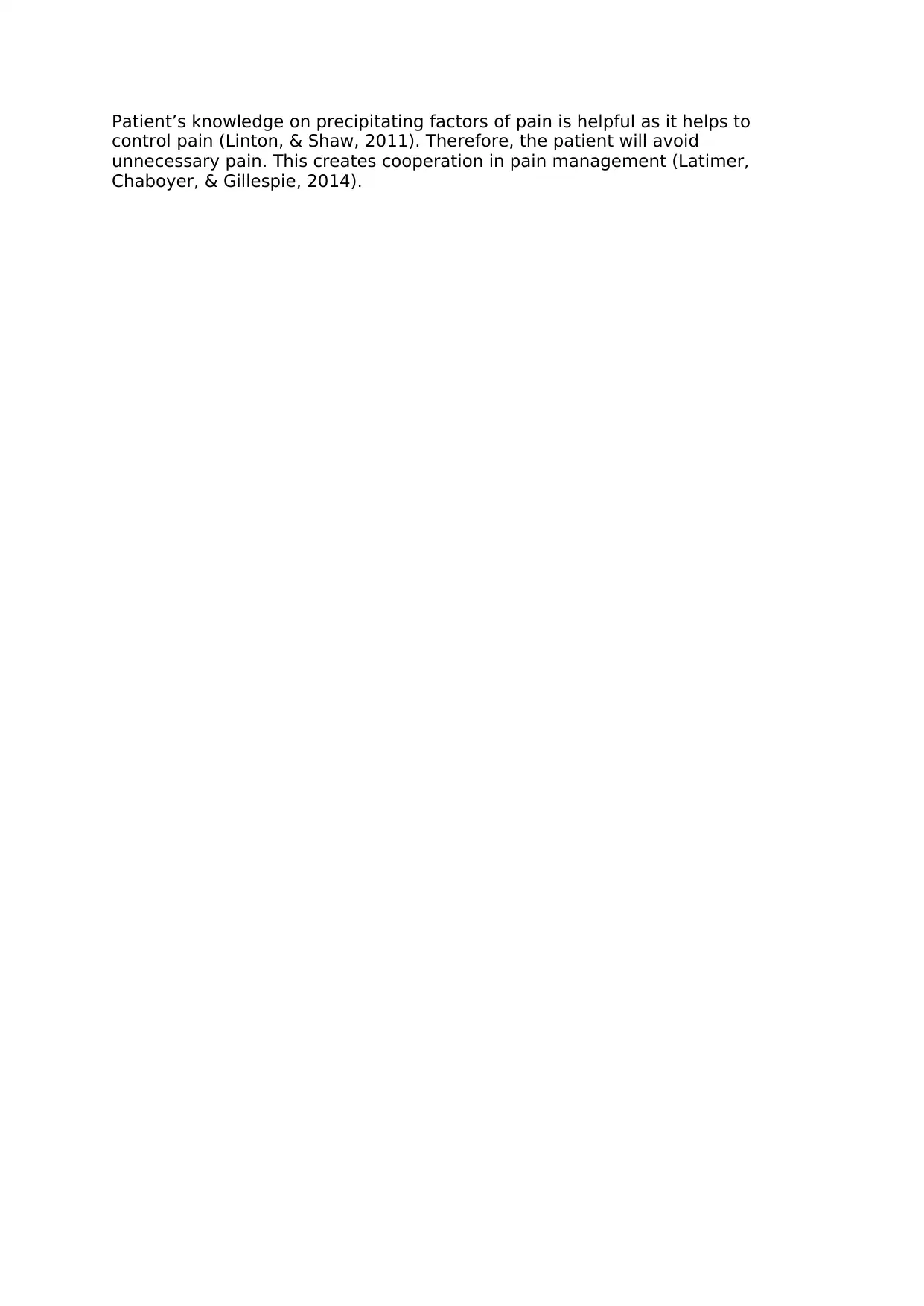
Patient’s knowledge on precipitating factors of pain is helpful as it helps to
control pain (Linton, & Shaw, 2011). Therefore, the patient will avoid
unnecessary pain. This creates cooperation in pain management (Latimer,
Chaboyer, & Gillespie, 2014).
control pain (Linton, & Shaw, 2011). Therefore, the patient will avoid
unnecessary pain. This creates cooperation in pain management (Latimer,
Chaboyer, & Gillespie, 2014).
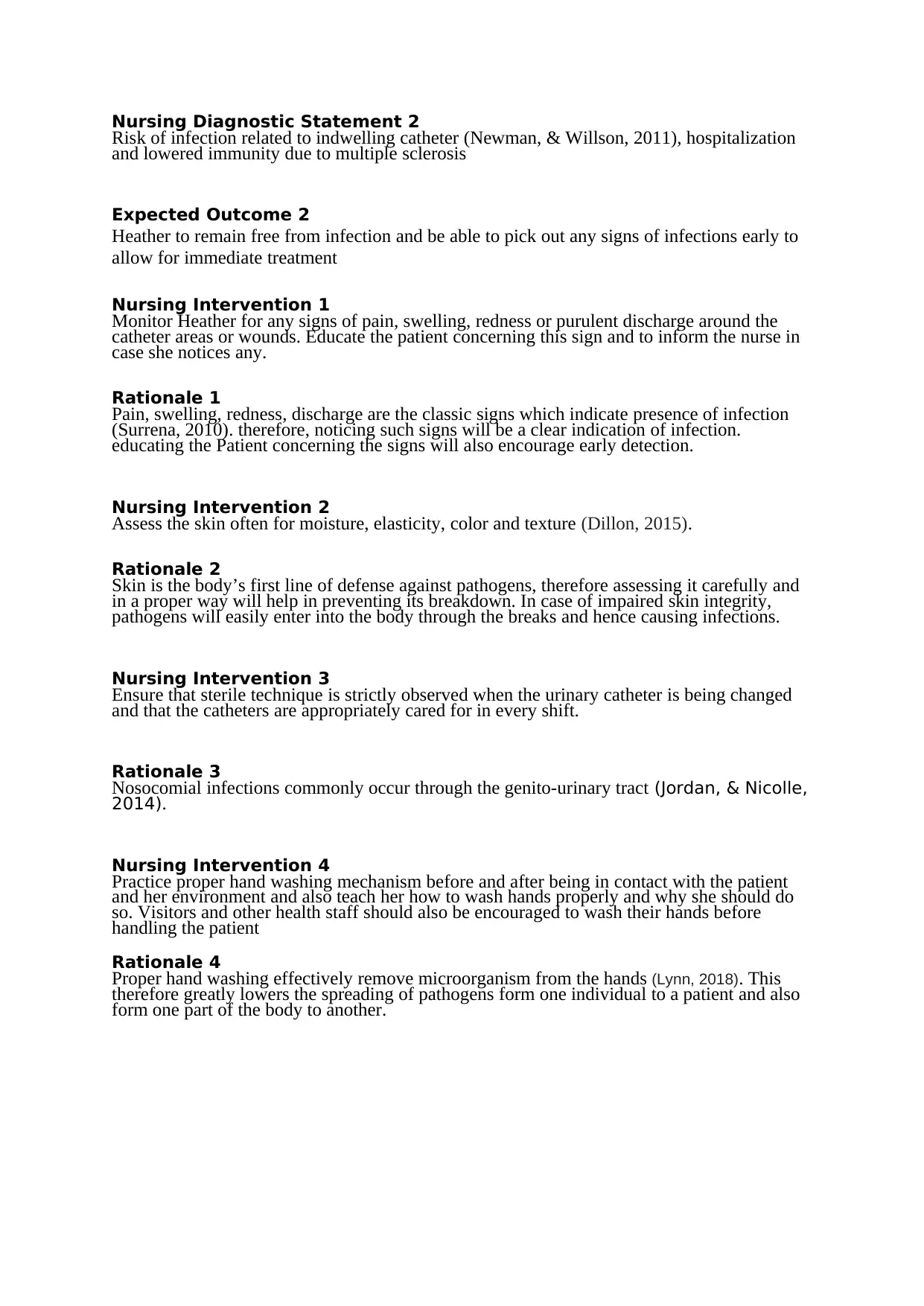
Nursing Diagnostic Statement 2
Risk of infection related to indwelling catheter (Newman, & Willson, 2011), hospitalization
and lowered immunity due to multiple sclerosis
Expected Outcome 2
Heather to remain free from infection and be able to pick out any signs of infections early to
allow for immediate treatment
Nursing Intervention 1
Monitor Heather for any signs of pain, swelling, redness or purulent discharge around the
catheter areas or wounds. Educate the patient concerning this sign and to inform the nurse in
case she notices any.
Rationale 1
Pain, swelling, redness, discharge are the classic signs which indicate presence of infection
(Surrena, 2010). therefore, noticing such signs will be a clear indication of infection.
educating the Patient concerning the signs will also encourage early detection.
Nursing Intervention 2
Assess the skin often for moisture, elasticity, color and texture (Dillon, 2015).
Rationale 2
Skin is the body’s first line of defense against pathogens, therefore assessing it carefully and
in a proper way will help in preventing its breakdown. In case of impaired skin integrity,
pathogens will easily enter into the body through the breaks and hence causing infections.
Nursing Intervention 3
Ensure that sterile technique is strictly observed when the urinary catheter is being changed
and that the catheters are appropriately cared for in every shift.
Rationale 3
Nosocomial infections commonly occur through the genito-urinary tract (Jordan, & Nicolle,
2014).
Nursing Intervention 4
Practice proper hand washing mechanism before and after being in contact with the patient
and her environment and also teach her how to wash hands properly and why she should do
so. Visitors and other health staff should also be encouraged to wash their hands before
handling the patient
Rationale 4
Proper hand washing effectively remove microorganism from the hands (Lynn, 2018). This
therefore greatly lowers the spreading of pathogens form one individual to a patient and also
form one part of the body to another.
Risk of infection related to indwelling catheter (Newman, & Willson, 2011), hospitalization
and lowered immunity due to multiple sclerosis
Expected Outcome 2
Heather to remain free from infection and be able to pick out any signs of infections early to
allow for immediate treatment
Nursing Intervention 1
Monitor Heather for any signs of pain, swelling, redness or purulent discharge around the
catheter areas or wounds. Educate the patient concerning this sign and to inform the nurse in
case she notices any.
Rationale 1
Pain, swelling, redness, discharge are the classic signs which indicate presence of infection
(Surrena, 2010). therefore, noticing such signs will be a clear indication of infection.
educating the Patient concerning the signs will also encourage early detection.
Nursing Intervention 2
Assess the skin often for moisture, elasticity, color and texture (Dillon, 2015).
Rationale 2
Skin is the body’s first line of defense against pathogens, therefore assessing it carefully and
in a proper way will help in preventing its breakdown. In case of impaired skin integrity,
pathogens will easily enter into the body through the breaks and hence causing infections.
Nursing Intervention 3
Ensure that sterile technique is strictly observed when the urinary catheter is being changed
and that the catheters are appropriately cared for in every shift.
Rationale 3
Nosocomial infections commonly occur through the genito-urinary tract (Jordan, & Nicolle,
2014).
Nursing Intervention 4
Practice proper hand washing mechanism before and after being in contact with the patient
and her environment and also teach her how to wash hands properly and why she should do
so. Visitors and other health staff should also be encouraged to wash their hands before
handling the patient
Rationale 4
Proper hand washing effectively remove microorganism from the hands (Lynn, 2018). This
therefore greatly lowers the spreading of pathogens form one individual to a patient and also
form one part of the body to another.
⊘ This is a preview!⊘
Do you want full access?
Subscribe today to unlock all pages.

Trusted by 1+ million students worldwide
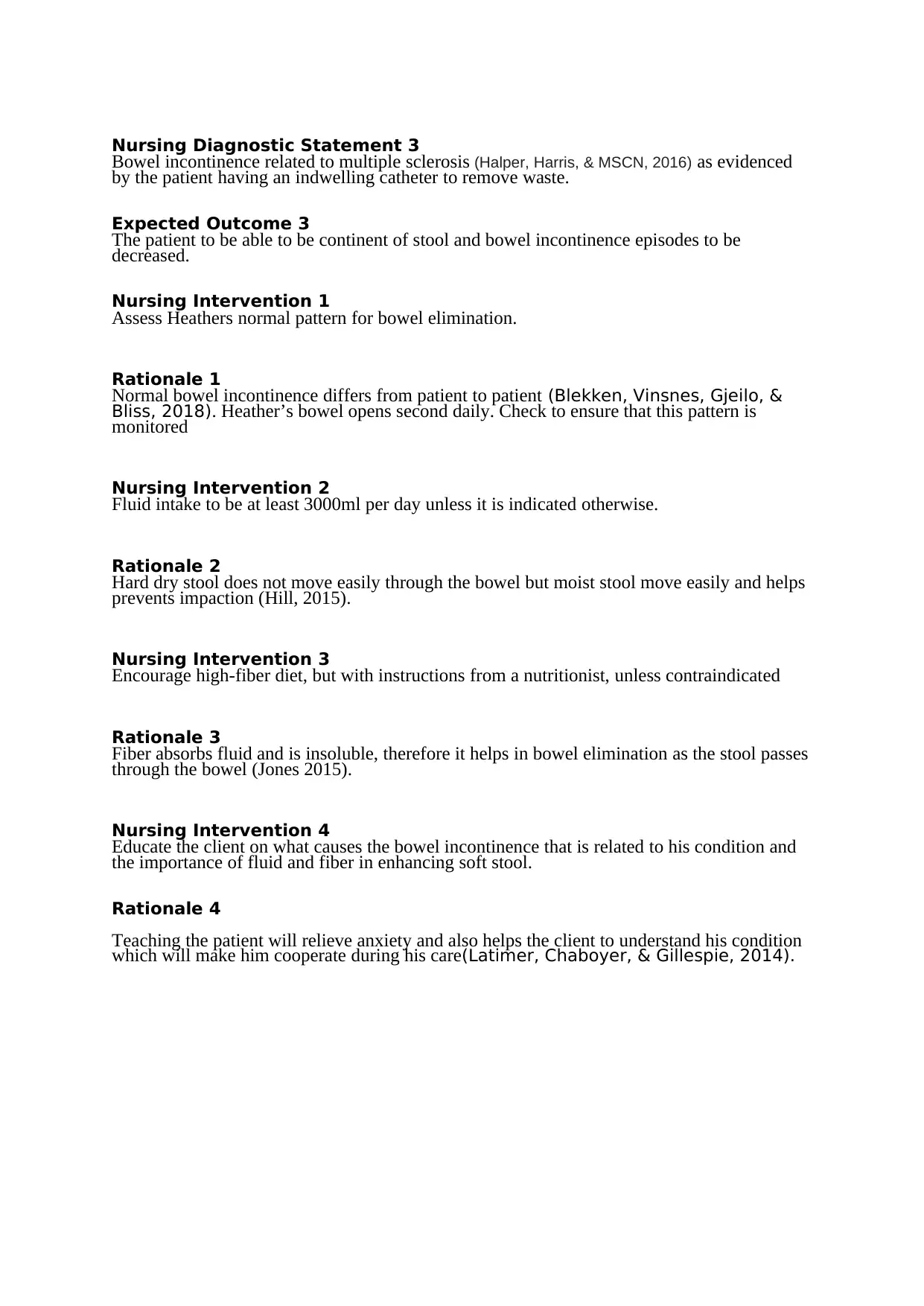
Nursing Diagnostic Statement 3
Bowel incontinence related to multiple sclerosis (Halper, Harris, & MSCN, 2016) as evidenced
by the patient having an indwelling catheter to remove waste.
Expected Outcome 3
The patient to be able to be continent of stool and bowel incontinence episodes to be
decreased.
Nursing Intervention 1
Assess Heathers normal pattern for bowel elimination.
Rationale 1
Normal bowel incontinence differs from patient to patient (Blekken, Vinsnes, Gjeilo, &
Bliss, 2018). Heather’s bowel opens second daily. Check to ensure that this pattern is
monitored
Nursing Intervention 2
Fluid intake to be at least 3000ml per day unless it is indicated otherwise.
Rationale 2
Hard dry stool does not move easily through the bowel but moist stool move easily and helps
prevents impaction (Hill, 2015).
Nursing Intervention 3
Encourage high-fiber diet, but with instructions from a nutritionist, unless contraindicated
Rationale 3
Fiber absorbs fluid and is insoluble, therefore it helps in bowel elimination as the stool passes
through the bowel (Jones 2015).
Nursing Intervention 4
Educate the client on what causes the bowel incontinence that is related to his condition and
the importance of fluid and fiber in enhancing soft stool.
Rationale 4
Teaching the patient will relieve anxiety and also helps the client to understand his condition
which will make him cooperate during his care(Latimer, Chaboyer, & Gillespie, 2014).
Bowel incontinence related to multiple sclerosis (Halper, Harris, & MSCN, 2016) as evidenced
by the patient having an indwelling catheter to remove waste.
Expected Outcome 3
The patient to be able to be continent of stool and bowel incontinence episodes to be
decreased.
Nursing Intervention 1
Assess Heathers normal pattern for bowel elimination.
Rationale 1
Normal bowel incontinence differs from patient to patient (Blekken, Vinsnes, Gjeilo, &
Bliss, 2018). Heather’s bowel opens second daily. Check to ensure that this pattern is
monitored
Nursing Intervention 2
Fluid intake to be at least 3000ml per day unless it is indicated otherwise.
Rationale 2
Hard dry stool does not move easily through the bowel but moist stool move easily and helps
prevents impaction (Hill, 2015).
Nursing Intervention 3
Encourage high-fiber diet, but with instructions from a nutritionist, unless contraindicated
Rationale 3
Fiber absorbs fluid and is insoluble, therefore it helps in bowel elimination as the stool passes
through the bowel (Jones 2015).
Nursing Intervention 4
Educate the client on what causes the bowel incontinence that is related to his condition and
the importance of fluid and fiber in enhancing soft stool.
Rationale 4
Teaching the patient will relieve anxiety and also helps the client to understand his condition
which will make him cooperate during his care(Latimer, Chaboyer, & Gillespie, 2014).
Paraphrase This Document
Need a fresh take? Get an instant paraphrase of this document with our AI Paraphraser
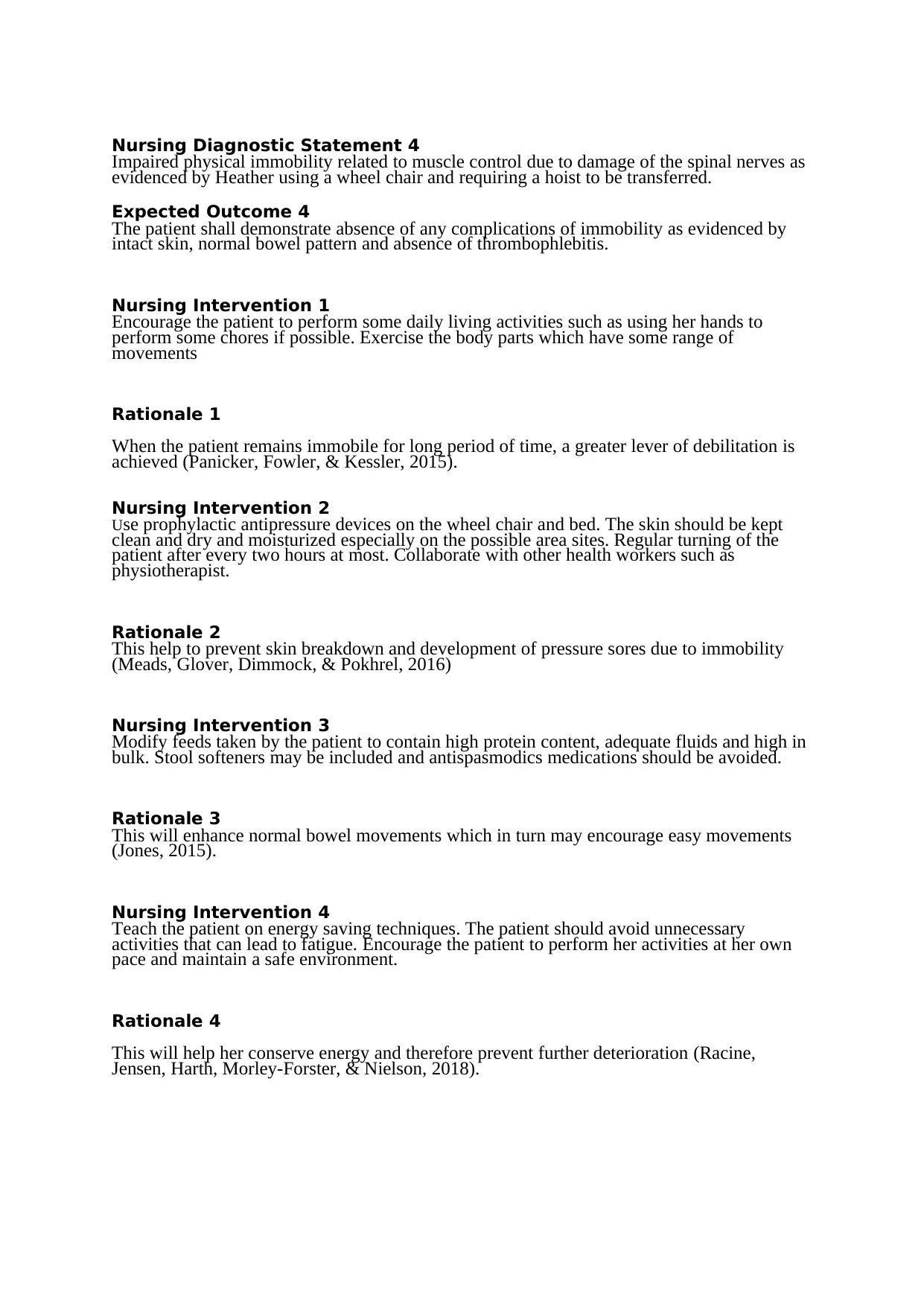
Nursing Diagnostic Statement 4
Impaired physical immobility related to muscle control due to damage of the spinal nerves as
evidenced by Heather using a wheel chair and requiring a hoist to be transferred.
Expected Outcome 4
The patient shall demonstrate absence of any complications of immobility as evidenced by
intact skin, normal bowel pattern and absence of thrombophlebitis.
Nursing Intervention 1
Encourage the patient to perform some daily living activities such as using her hands to
perform some chores if possible. Exercise the body parts which have some range of
movements
Rationale 1
When the patient remains immobile for long period of time, a greater lever of debilitation is
achieved (Panicker, Fowler, & Kessler, 2015).
Nursing Intervention 2
Use prophylactic antipressure devices on the wheel chair and bed. The skin should be kept
clean and dry and moisturized especially on the possible area sites. Regular turning of the
patient after every two hours at most. Collaborate with other health workers such as
physiotherapist.
Rationale 2
This help to prevent skin breakdown and development of pressure sores due to immobility
(Meads, Glover, Dimmock, & Pokhrel, 2016)
Nursing Intervention 3
Modify feeds taken by the patient to contain high protein content, adequate fluids and high in
bulk. Stool softeners may be included and antispasmodics medications should be avoided.
Rationale 3
This will enhance normal bowel movements which in turn may encourage easy movements
(Jones, 2015).
Nursing Intervention 4
Teach the patient on energy saving techniques. The patient should avoid unnecessary
activities that can lead to fatigue. Encourage the patient to perform her activities at her own
pace and maintain a safe environment.
Rationale 4
This will help her conserve energy and therefore prevent further deterioration (Racine,
Jensen, Harth, Morley-Forster, & Nielson, 2018).
Impaired physical immobility related to muscle control due to damage of the spinal nerves as
evidenced by Heather using a wheel chair and requiring a hoist to be transferred.
Expected Outcome 4
The patient shall demonstrate absence of any complications of immobility as evidenced by
intact skin, normal bowel pattern and absence of thrombophlebitis.
Nursing Intervention 1
Encourage the patient to perform some daily living activities such as using her hands to
perform some chores if possible. Exercise the body parts which have some range of
movements
Rationale 1
When the patient remains immobile for long period of time, a greater lever of debilitation is
achieved (Panicker, Fowler, & Kessler, 2015).
Nursing Intervention 2
Use prophylactic antipressure devices on the wheel chair and bed. The skin should be kept
clean and dry and moisturized especially on the possible area sites. Regular turning of the
patient after every two hours at most. Collaborate with other health workers such as
physiotherapist.
Rationale 2
This help to prevent skin breakdown and development of pressure sores due to immobility
(Meads, Glover, Dimmock, & Pokhrel, 2016)
Nursing Intervention 3
Modify feeds taken by the patient to contain high protein content, adequate fluids and high in
bulk. Stool softeners may be included and antispasmodics medications should be avoided.
Rationale 3
This will enhance normal bowel movements which in turn may encourage easy movements
(Jones, 2015).
Nursing Intervention 4
Teach the patient on energy saving techniques. The patient should avoid unnecessary
activities that can lead to fatigue. Encourage the patient to perform her activities at her own
pace and maintain a safe environment.
Rationale 4
This will help her conserve energy and therefore prevent further deterioration (Racine,
Jensen, Harth, Morley-Forster, & Nielson, 2018).

Handover of care (use iSoBAR format)
Handover to: next shift nurse
Identity: Hi, my name is -. I am a student from Curtin hospital ward 9A a medical
ward. I am handing over about my patient known by the name of Heather Cook,
48 years old woman.
Situation: My patient was admitted from home with her husband in attendance.
She had a non-blanchable redness over her right ischial tuberosity on
examination. The skin was intact and had a long term IDC insitu.
Observation: Recent vital signs include respiratory rate of 24 breaths per minute,
pulse of 138 bpm, blood pressure of 100/80 mmHg and temperature of 37.7 on
admission. The patient complained of pain. The score out of 7 out of 10.
Background: Heather was diagnosed with multiple sclerosis when she was 30
years old. She has been managing her condition well with the help of nurses at
her home. The pressure ulcer was a result of her sitting on her wheel chair for a
long time because the nurses were coming late. The patient is not on any current
medication and no known drug reaction.
Agreed plan: Continue with management of the stage one pressure area to
prevent it from advancing more.
Recommendation: Continue monitoring vital signs and relief pressure every 15
minutes by changing patient position. Pain monitoring should also be done.
Discharge Plan
Heather was admitted to ward 9A for management of stage 1 pressure injury.
She is married, Anglo-Australian, Anglican lady and she came accompanied by
her husband.
Advise the guardian or husband to ensure that medications are given at home as
prescribed without fail in order to ensure maximum management of symptoms.
Encourage them to consult whenever they encounter a challenge concerning
medications and to avoid over the counter drugs. Advise them to also provide an
environment that is clean while at home and also a safe environment since
heather does not move easily.
Heather to be instructed to continue taking fluids of up to 3000 ml per day and
ensure that he have a complete bed rest. Teach to maintain hygiene by ensuring
that he bath daily and to also continue with proper hand washing technique.
Encourage Heather to continue with follow-up by the doctor. Teach also on how
to eat proper balanced diet while at home and on the importance of taking food
rich in fiber concerning her condition. The family to also be provided with
emotional support and be reassured concerning Heather’s condition.
Handover to: next shift nurse
Identity: Hi, my name is -. I am a student from Curtin hospital ward 9A a medical
ward. I am handing over about my patient known by the name of Heather Cook,
48 years old woman.
Situation: My patient was admitted from home with her husband in attendance.
She had a non-blanchable redness over her right ischial tuberosity on
examination. The skin was intact and had a long term IDC insitu.
Observation: Recent vital signs include respiratory rate of 24 breaths per minute,
pulse of 138 bpm, blood pressure of 100/80 mmHg and temperature of 37.7 on
admission. The patient complained of pain. The score out of 7 out of 10.
Background: Heather was diagnosed with multiple sclerosis when she was 30
years old. She has been managing her condition well with the help of nurses at
her home. The pressure ulcer was a result of her sitting on her wheel chair for a
long time because the nurses were coming late. The patient is not on any current
medication and no known drug reaction.
Agreed plan: Continue with management of the stage one pressure area to
prevent it from advancing more.
Recommendation: Continue monitoring vital signs and relief pressure every 15
minutes by changing patient position. Pain monitoring should also be done.
Discharge Plan
Heather was admitted to ward 9A for management of stage 1 pressure injury.
She is married, Anglo-Australian, Anglican lady and she came accompanied by
her husband.
Advise the guardian or husband to ensure that medications are given at home as
prescribed without fail in order to ensure maximum management of symptoms.
Encourage them to consult whenever they encounter a challenge concerning
medications and to avoid over the counter drugs. Advise them to also provide an
environment that is clean while at home and also a safe environment since
heather does not move easily.
Heather to be instructed to continue taking fluids of up to 3000 ml per day and
ensure that he have a complete bed rest. Teach to maintain hygiene by ensuring
that he bath daily and to also continue with proper hand washing technique.
Encourage Heather to continue with follow-up by the doctor. Teach also on how
to eat proper balanced diet while at home and on the importance of taking food
rich in fiber concerning her condition. The family to also be provided with
emotional support and be reassured concerning Heather’s condition.
⊘ This is a preview!⊘
Do you want full access?
Subscribe today to unlock all pages.

Trusted by 1+ million students worldwide
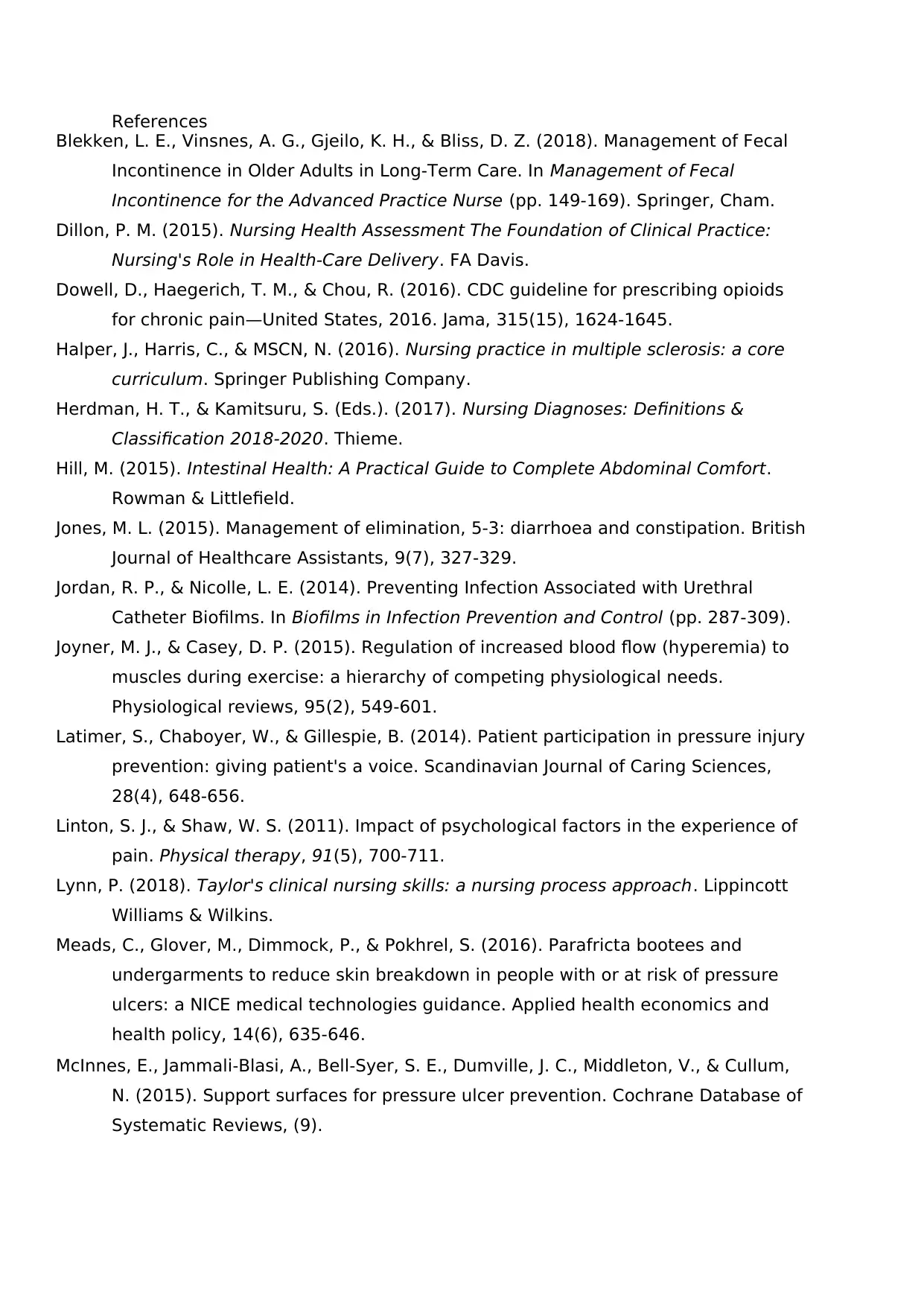
References
Blekken, L. E., Vinsnes, A. G., Gjeilo, K. H., & Bliss, D. Z. (2018). Management of Fecal
Incontinence in Older Adults in Long-Term Care. In Management of Fecal
Incontinence for the Advanced Practice Nurse (pp. 149-169). Springer, Cham.
Dillon, P. M. (2015). Nursing Health Assessment The Foundation of Clinical Practice:
Nursing's Role in Health-Care Delivery. FA Davis.
Dowell, D., Haegerich, T. M., & Chou, R. (2016). CDC guideline for prescribing opioids
for chronic pain—United States, 2016. Jama, 315(15), 1624-1645.
Halper, J., Harris, C., & MSCN, N. (2016). Nursing practice in multiple sclerosis: a core
curriculum. Springer Publishing Company.
Herdman, H. T., & Kamitsuru, S. (Eds.). (2017). Nursing Diagnoses: Definitions &
Classification 2018-2020. Thieme.
Hill, M. (2015). Intestinal Health: A Practical Guide to Complete Abdominal Comfort.
Rowman & Littlefield.
Jones, M. L. (2015). Management of elimination, 5-3: diarrhoea and constipation. British
Journal of Healthcare Assistants, 9(7), 327-329.
Jordan, R. P., & Nicolle, L. E. (2014). Preventing Infection Associated with Urethral
Catheter Biofilms. In Biofilms in Infection Prevention and Control (pp. 287-309).
Joyner, M. J., & Casey, D. P. (2015). Regulation of increased blood flow (hyperemia) to
muscles during exercise: a hierarchy of competing physiological needs.
Physiological reviews, 95(2), 549-601.
Latimer, S., Chaboyer, W., & Gillespie, B. (2014). Patient participation in pressure injury
prevention: giving patient's a voice. Scandinavian Journal of Caring Sciences,
28(4), 648-656.
Linton, S. J., & Shaw, W. S. (2011). Impact of psychological factors in the experience of
pain. Physical therapy, 91(5), 700-711.
Lynn, P. (2018). Taylor's clinical nursing skills: a nursing process approach. Lippincott
Williams & Wilkins.
Meads, C., Glover, M., Dimmock, P., & Pokhrel, S. (2016). Parafricta bootees and
undergarments to reduce skin breakdown in people with or at risk of pressure
ulcers: a NICE medical technologies guidance. Applied health economics and
health policy, 14(6), 635-646.
McInnes, E., Jammali‐Blasi, A., Bell‐Syer, S. E., Dumville, J. C., Middleton, V., & Cullum,
N. (2015). Support surfaces for pressure ulcer prevention. Cochrane Database of
Systematic Reviews, (9).
Blekken, L. E., Vinsnes, A. G., Gjeilo, K. H., & Bliss, D. Z. (2018). Management of Fecal
Incontinence in Older Adults in Long-Term Care. In Management of Fecal
Incontinence for the Advanced Practice Nurse (pp. 149-169). Springer, Cham.
Dillon, P. M. (2015). Nursing Health Assessment The Foundation of Clinical Practice:
Nursing's Role in Health-Care Delivery. FA Davis.
Dowell, D., Haegerich, T. M., & Chou, R. (2016). CDC guideline for prescribing opioids
for chronic pain—United States, 2016. Jama, 315(15), 1624-1645.
Halper, J., Harris, C., & MSCN, N. (2016). Nursing practice in multiple sclerosis: a core
curriculum. Springer Publishing Company.
Herdman, H. T., & Kamitsuru, S. (Eds.). (2017). Nursing Diagnoses: Definitions &
Classification 2018-2020. Thieme.
Hill, M. (2015). Intestinal Health: A Practical Guide to Complete Abdominal Comfort.
Rowman & Littlefield.
Jones, M. L. (2015). Management of elimination, 5-3: diarrhoea and constipation. British
Journal of Healthcare Assistants, 9(7), 327-329.
Jordan, R. P., & Nicolle, L. E. (2014). Preventing Infection Associated with Urethral
Catheter Biofilms. In Biofilms in Infection Prevention and Control (pp. 287-309).
Joyner, M. J., & Casey, D. P. (2015). Regulation of increased blood flow (hyperemia) to
muscles during exercise: a hierarchy of competing physiological needs.
Physiological reviews, 95(2), 549-601.
Latimer, S., Chaboyer, W., & Gillespie, B. (2014). Patient participation in pressure injury
prevention: giving patient's a voice. Scandinavian Journal of Caring Sciences,
28(4), 648-656.
Linton, S. J., & Shaw, W. S. (2011). Impact of psychological factors in the experience of
pain. Physical therapy, 91(5), 700-711.
Lynn, P. (2018). Taylor's clinical nursing skills: a nursing process approach. Lippincott
Williams & Wilkins.
Meads, C., Glover, M., Dimmock, P., & Pokhrel, S. (2016). Parafricta bootees and
undergarments to reduce skin breakdown in people with or at risk of pressure
ulcers: a NICE medical technologies guidance. Applied health economics and
health policy, 14(6), 635-646.
McInnes, E., Jammali‐Blasi, A., Bell‐Syer, S. E., Dumville, J. C., Middleton, V., & Cullum,
N. (2015). Support surfaces for pressure ulcer prevention. Cochrane Database of
Systematic Reviews, (9).
Paraphrase This Document
Need a fresh take? Get an instant paraphrase of this document with our AI Paraphraser
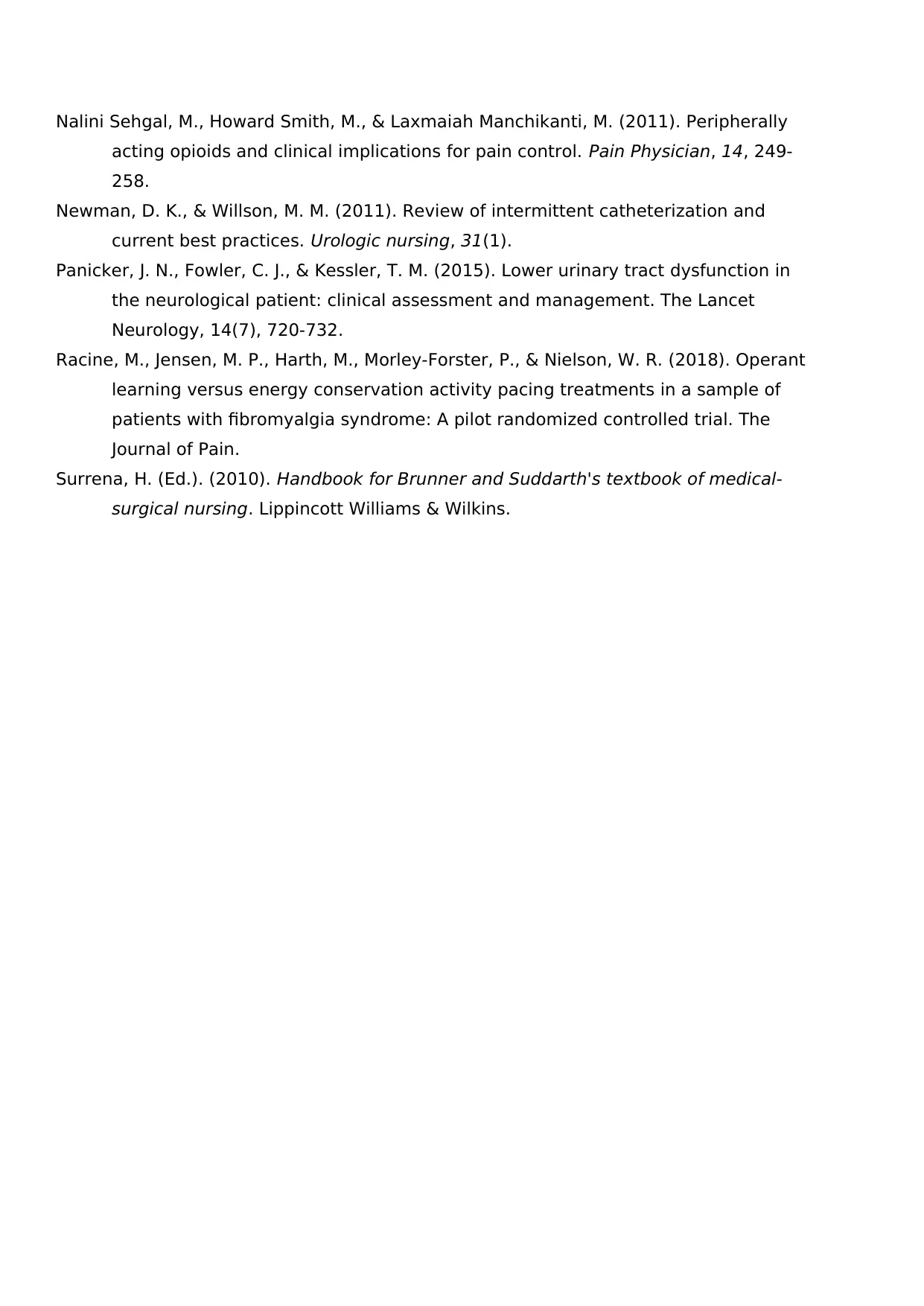
Nalini Sehgal, M., Howard Smith, M., & Laxmaiah Manchikanti, M. (2011). Peripherally
acting opioids and clinical implications for pain control. Pain Physician, 14, 249-
258.
Newman, D. K., & Willson, M. M. (2011). Review of intermittent catheterization and
current best practices. Urologic nursing, 31(1).
Panicker, J. N., Fowler, C. J., & Kessler, T. M. (2015). Lower urinary tract dysfunction in
the neurological patient: clinical assessment and management. The Lancet
Neurology, 14(7), 720-732.
Racine, M., Jensen, M. P., Harth, M., Morley-Forster, P., & Nielson, W. R. (2018). Operant
learning versus energy conservation activity pacing treatments in a sample of
patients with fibromyalgia syndrome: A pilot randomized controlled trial. The
Journal of Pain.
Surrena, H. (Ed.). (2010). Handbook for Brunner and Suddarth's textbook of medical-
surgical nursing. Lippincott Williams & Wilkins.
acting opioids and clinical implications for pain control. Pain Physician, 14, 249-
258.
Newman, D. K., & Willson, M. M. (2011). Review of intermittent catheterization and
current best practices. Urologic nursing, 31(1).
Panicker, J. N., Fowler, C. J., & Kessler, T. M. (2015). Lower urinary tract dysfunction in
the neurological patient: clinical assessment and management. The Lancet
Neurology, 14(7), 720-732.
Racine, M., Jensen, M. P., Harth, M., Morley-Forster, P., & Nielson, W. R. (2018). Operant
learning versus energy conservation activity pacing treatments in a sample of
patients with fibromyalgia syndrome: A pilot randomized controlled trial. The
Journal of Pain.
Surrena, H. (Ed.). (2010). Handbook for Brunner and Suddarth's textbook of medical-
surgical nursing. Lippincott Williams & Wilkins.
1 out of 8
Your All-in-One AI-Powered Toolkit for Academic Success.
+13062052269
info@desklib.com
Available 24*7 on WhatsApp / Email
![[object Object]](/_next/static/media/star-bottom.7253800d.svg)
Unlock your academic potential
Copyright © 2020–2025 A2Z Services. All Rights Reserved. Developed and managed by ZUCOL.
